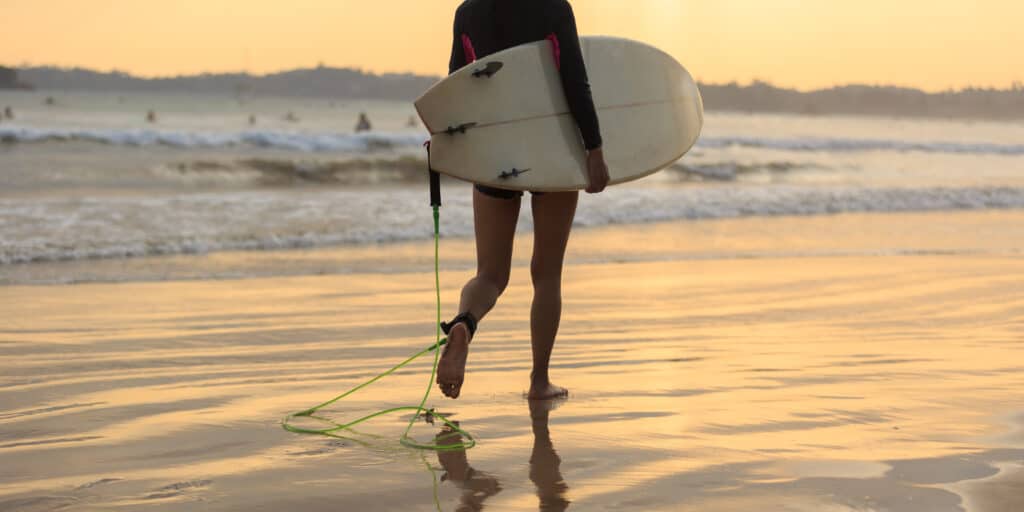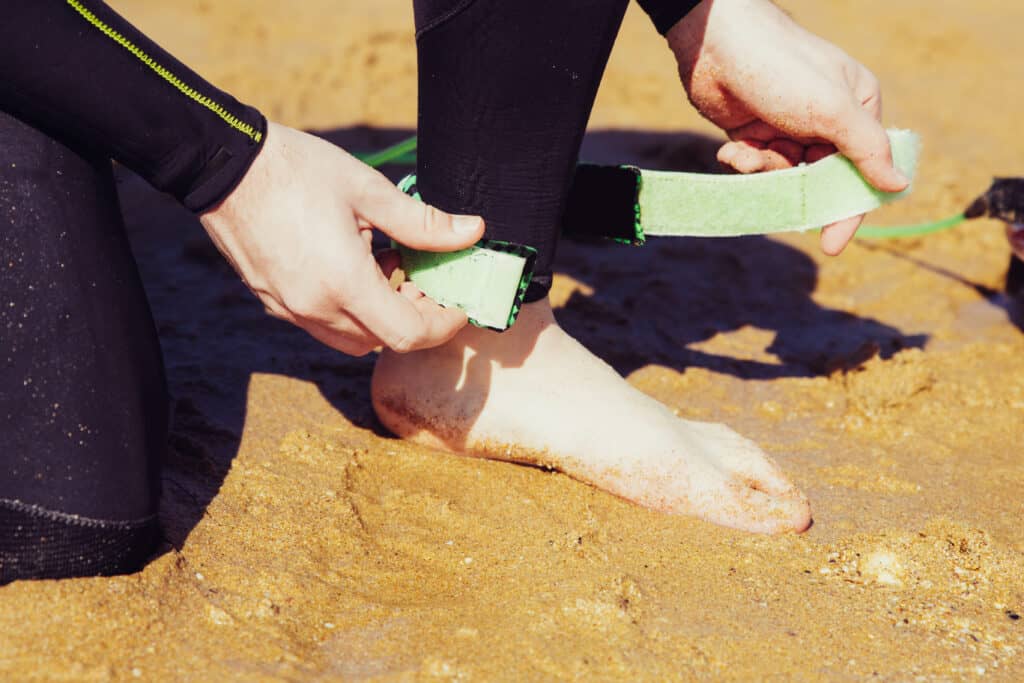
Most surfers wear a surfboard leash, and all modern surfboards are manufactured with a leash plug for the leash attachment, regardless of size and shape. However, now and then, we see some surfers, especially longboarders, do not wear leashes when they surf.
Let’s find out whether you should surf with a leash or not.
Generally, all surfers should wear a leash when surfing with other people. It is convenient for the surfer and safer for the fellow surfers and beachgoers: Without a leash, a surfboard can travel with the waves and cause harm to people in the water.
Let’s dive deeper into the benefits of wearing a leash and the potential consequences of not wearing one.
Why do you need a leash for a surfboard?
A surfboard leash provides convenience and safety for you and others around you.
- A surfboard leash ensures the board stays with a surfer, making retrieving the board much easier. Without a leash, a surfer must swim to the board every time he falls off the board, and no one can surf without wipeouts.
- When riding bigger waves, a leash may save your life. No one is leashless when they charge for big waves. The surfboard is much more buoyant than us, and you want your board close to you when you are in trouble.
- Most people have limited time to surf, and it’s better to spend more time riding a wave than swimming to get the board.
- Safety. Have you tried to dodge a loose surfboard approaching you with a wave? It’s not easy! The wave generally travels faster than you can wade, swim or paddle. Furthermore, when the wave is carrying the board, it does not always travel directly towards the shore and may come at an angle. So it might be too late when you try to figure out how to avoid the collision.
- The longboard weighs around 6-7kg ( 15-16 pounds), and the surface is generally hard fibreglass. With the speed of the wave, the impact generated by the loose board can be quite a significant force, especially for children.
Why do some surfers not wear a surfboard leash?
Some longboarders do not wear a surfboard leash to avoid tangling the leash around them while they walk and move around the board.
During professional longboard competitions, the pro surfers do not wear a leash.
This is acceptable as the surfing zones are cleared out for surfing competition and must perform maneuvers like nose riding and spinning around.
However, this cannot be the same for an average Joe on the crowded beach. Unless you turn around 360 on the board, the leash does not usually get tangled on you. No one can avoid wipeout 100 percent and it is the surfer’s responsibility not to cause avoidable harm.
Recognising the danger, Byron Bay, Australia, have made leash compulsory in the surf, and it’s against the law if you do not obey them.
Some surfers claim that the leash slows them down while they paddle and ride a wave. The leash does cause drag, and it MAY slow you down. However, this would be a minor drag and would not affect the performance most of the time. Remember, pro surfers always wear a leash, and they seem to be just fine performing all the necessary maneuvers.
Ankle vs Calf Leash For Longboard

For Longboard leashes only, it comes in two different options for their attachment. Ankle strap and Calf/knee strap. According to many reputable surf shop owners in Sydney, the choice is purely a personal preference.
Some people may feel too much tug at the ankle for ankle leashes, especially female surfers. The longboard is relatively heavy, and when the wave pushes the board after a wipeout, there can be quite a pull in the ankle where the leash is attached. Therefore, attaching the leash to a larger knee joint may reduce the tug you experience.
Also, some surfers claim that having an attachment higher, you are less likely to get tangled or step on the cord of the leash. This, however, is not proven, and I suggest you go with what feels right for you. For most people, you can put the ankle strap on the knee. See if it helps you surf more comfortably before committing to buy a new calf/knee leash.
What happens if you harm other people because you chose not to wear a surfboard leash?
(This is not legal advice – contents were based on the following article)
While most people do not wish to pursue legal action, If you cause an injury to a person by not wearing a surfboard leash, you may get sued. It is widely accepted in the surfing community that letting your board loose while surfing is dangerous. You should consider risk and reward when deciding to surf without a leash.
So it’s clear that wearing a surfboard leash is a wise choice for most surfers. How do you choose the right surfboard leash if you must wear one?
Choosing the right surfboard leash – Does surfboard leash length matter?
Many manufacturers are producing high-quality surfboard leashes. The first step is to get the correct length. A too-long leash causes unnecessary drag in the water and increases the chances of getting tangled. A too short leash may place your board too close to you during a wipeout, potentially causing injury. Please see the table below, created after discussing several reputable surfboard shop owners in Sydney.
| Surfboard Length range | Length of leg rope / Leash |
| 6″0 – 6″6 | 6-foot leg rope |
| 6″8 – 7″6 | 7-foot leg rope |
| 7″8 – 8″6 | 8-foot leg rope |
| 8″8 – 9″6 | 9-foot leg rope |
For 6 foot leash, you may choose the thickness of the chord. The thinner cord will cause less drag, but the strength of the leash is compromised. Therefore, the manufacturer generally does not recommend surfers use these leashes on waves bigger than 4 feet.
Conclusion
Wearing a leash is safer for yourself and others in the water. Thanks to all advancements in the technology in surfing equipment, you won’t even feel that you are wearing one while surfing. Remember, the best surfer is the one having the most fun. Surf more and Enjoy!

